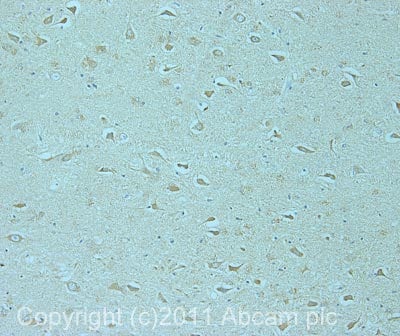Anti-SIK2 antibody (ab53423)
Key features and details
- Rabbit polyclonal to SIK2
- Suitable for: WB, IHC-P
- Reacts with: Human
- Isotype: IgG
Overview
-
Product name
Anti-SIK2 antibody
See all SIK2 primary antibodies -
Description
Rabbit polyclonal to SIK2 -
Host species
Rabbit -
Tested Applications & Species
See all applications and species dataApplication Species IHC-P HumanWB Human -
Immunogen
Synthetic peptide within Human SIK2 aa 100-150. The exact sequence is proprietary.
Database link: NP_056006 -
Positive control
-
General notes
This product was previously labelled as Snf1lk2, Snf1lk+Snf1lk2+SIK3
Properties
-
Form
Liquid -
Storage instructions
Shipped at 4°C. Store at +4°C short term (1-2 weeks). Upon delivery aliquot. Store at -20°C long term. -
Storage buffer
pH: 7.4
Preservative: 0.05% Sodium azide
Constituents: 0.05% BSA, PBS -
 Concentration information loading...
Concentration information loading... -
Purity
Protein G purified -
Clonality
Polyclonal -
Isotype
IgG -
Research areas
Images
-
All lanes : Anti-SIK2 antibody (ab53423) at 2 µg/ml
Lane 1 : Human brain
Lane 2 : Human brain with immunizing peptide
Predicted band size: 104 kDa
Observed band size: 120 kDa why is the actual band size different from the predicted?
Additional bands at: 25 kDa. We are unsure as to the identity of these extra bands.
NB While the predicted molecular weight is 104kDa, both the bands at 120kDa and at 25kDa are blocked by immunizing peptide. -
IHC image of ab53423 staining in human hippocampus formalin fixed paraffin embedded tissue section, performed on a Leica BondTM system using the standard protocol F. The section was pre-treated using heat mediated antigen retrieval with sodium citrate buffer (pH6, epitope retrieval solution 1) for 20 mins. The section was then incubated with ab53423, 5µg/ml, for 15 mins at room temperature and detected using an HRP conjugated compact polymer system. DAB was used as the chromogen. The section was then counterstained with haematoxylin and mounted with DPX.
For other IHC staining systems (automated and non-automated) customers should optimize variable parameters such as antigen retrieval conditions, primary antibody concentration and antibody incubation times.











